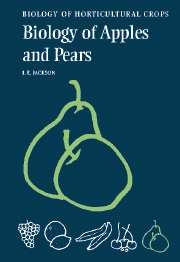Book contents
- Frontmatter
- Contents
- Preface
- Acknowledgements
- Introduction
- 1 The growing of apples and pears
- 2 Apples and pears and their relatives
- 3 Apple and pear root systems: induction, development, structure and function
- 4 The graft union, grafting and budding
- 5 Mechanisms of rootstock and interstock effects on scion vigour
- 6 The shoot system
- 7 Leaves, canopies and light interception
- 8 Photosynthesis, respiration, and carbohydrate transport, partitioning and storage
- 9 Flowers and fruits
- 10 Eating quality and its retention
- 11 Mineral nutrition
- 12 Water relations
- 13 Diseases, pests, and resistance to these
- 14 Biotechnology of apples and pears
- Cultivar Index
- General Index
- References
1 - The growing of apples and pears
Published online by Cambridge University Press: 13 August 2009
- Frontmatter
- Contents
- Preface
- Acknowledgements
- Introduction
- 1 The growing of apples and pears
- 2 Apples and pears and their relatives
- 3 Apple and pear root systems: induction, development, structure and function
- 4 The graft union, grafting and budding
- 5 Mechanisms of rootstock and interstock effects on scion vigour
- 6 The shoot system
- 7 Leaves, canopies and light interception
- 8 Photosynthesis, respiration, and carbohydrate transport, partitioning and storage
- 9 Flowers and fruits
- 10 Eating quality and its retention
- 11 Mineral nutrition
- 12 Water relations
- 13 Diseases, pests, and resistance to these
- 14 Biotechnology of apples and pears
- Cultivar Index
- General Index
- References
Summary
The history of apple and pear growing
Apples and pears in the wild and in prehistory
The genus Malus has, according to most authorities, 25 to 30 species and several subspecies of so-called crab apples. These species are found in the wild almost continuously throughout temperate Eurasia and North America. The primary centre of diversity appears to be within a region stretching from Asia Minor to the western provinces of China (Janick et al., 1996; Juniper et al., 1999, 2001). Forests of wild apples are still found in this region (Roach, 1985), with fruits ranging from small and unattractive to ones similar to the traditional cultivated eating apples.
There is evidence that the fruits of apples were collected as food by prehistoric man. Carbonized fruits dating from 6500 BC were found at çatal Hüyük in Anatolia and remains of both sour crab apples and a larger form, which may have been cultivated, were discovered in prehistoric lake dwellings in Switzerland. It seems likely that apples moved with human migration along the Old Silk Roads linking western China with the Near East and Danube valley even in Neolithic and Bronze Age times. These routes passed through Almaten (Alma Ata) in eastern Kazakhstan and the northern slopes of the Tien Shan Mountains, now thought to be the possible centre of origin of the domestic apple (Juniper et al., 2001).
- Type
- Chapter
- Information
- The Biology of Apples and Pears , pp. 4 - 21Publisher: Cambridge University PressPrint publication year: 2003
References
- 2
- Cited by



